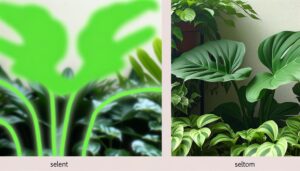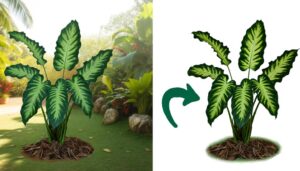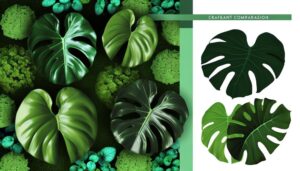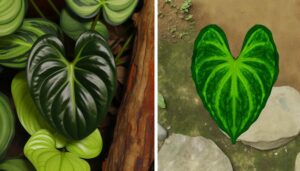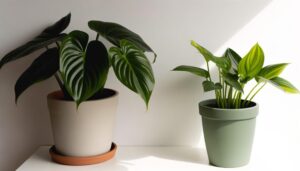Philodendron Pink Congo Vs Pink Princess: Key Differences
Philodendron Pink Congo and Philodendron erubescens ‘Pink Princess’ differ significantly in origin and foliage. Pink Congo, chemically induced, shows uniform pink leaves that revert to green, featuring smooth, elongated leaves.
In contrast, Pink Princess, a traditional hybrid, boasts stable pink, green, and white variegated, heart-shaped leaves. Growth-wise, Pink Congo exhibits rapid vertical growth with limited branching, while Pink Princess has a compact, bushy form.
Both require bright, indirect light and careful watering. Understanding their unique variegation methods and growth characteristics can greatly enhance their cultivation and aesthetic appeal.
For detailed insights and best care tips, explore further.
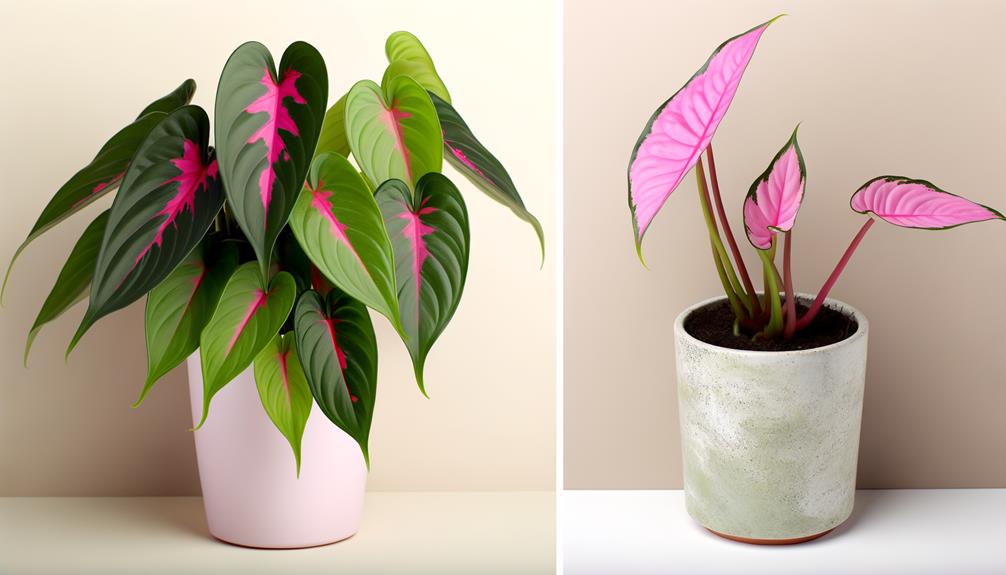
Key Takeaways
- Philodendron Pink Congo’s pink leaves revert to green, while Pink Princess’s variegation remains stable.
- Pink Congo’s pink coloration is chemically induced, whereas Pink Princess achieves variegation through traditional hybridization.
- Pink Princess has a compact, bushy growth habit; Pink Congo grows rapidly and vertically.
- Both plants require bright, indirect light for optimal coloration and growth.
- Pink Princess originates from South American rainforests, while Pink Congo’s background involves chemical treatment for its color.
Characteristic of Philodendron Pink Congo vs Pink Princess
| Characteristic | Philodendron Pink Congo | Philodendron Pink Princess |
|---|---|---|
| Leaf Color & Variegation | Leaves turn solid pink temporarily, with green foliage reverting over time. | Leaves display natural pink variegation, mixed with dark green or blackish tones, which remains consistent. |
| Variegation Stability | Artificially induced pink coloring, which fades after a few months. | Natural variegation that is genetically stable and long-lasting. |
| Growth Habit | Upright growth, compact and bushy appearance. | Trailing or climbing growth habit, can be trained on a trellis or allowed to cascade. |
| Leaf Shape | Oval, smooth-edged leaves that are solid green or pink. | Heart-shaped leaves with a mix of pink and dark green, giving it a more dramatic appearance. |
| Size | Grows up to 2 feet tall, making it ideal for smaller indoor spaces. | Can grow up to 3-4 feet tall when climbing, with large, broad leaves. |
| Light Requirements | Thrives in bright, indirect light, but color fades in lower light. | Prefers bright, indirect light for strong variegation; lower light reduces pink color intensity. |
| Care Difficulty | Easy to care for, but pink color fades over time. | Moderate care, requires good lighting and consistent conditions to maintain variegation. |
| Native Region | Hybrid variety, developed for its striking color but not naturally occurring. | Native to Colombia, where it grows in tropical rainforests. |
Origins and Background
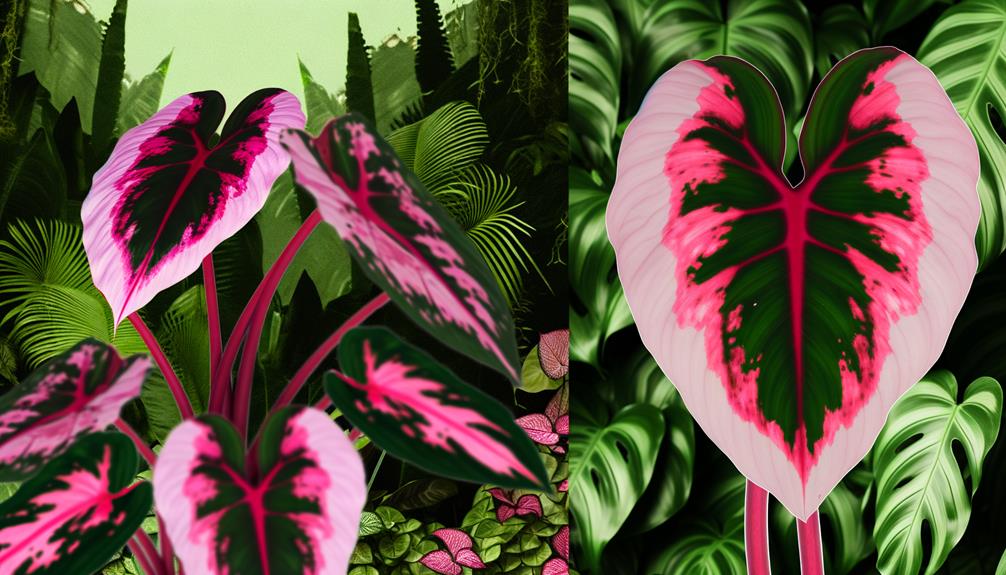
Philodendron Pink Congo and Philodendron erubescens ‘Pink Princess‘ are two distinct cultivars within the Araceae family, each with unique origins and breeding history.
Philodendron Pink Congo is a relatively recent introduction, believed to be developed through chemical inducement to produce its signature pink coloration temporarily. Its exact breeding methods remain somewhat proprietary, leading to debate among horticulturalists.
In contrast, Philodendron erubescens ‘Pink Princess’ boasts a more natural variegation, achieved through traditional hybridization techniques. Originating from the tropical rainforests of South America, ‘Pink Princess’ has been selectively bred to enhance its aesthetic appeal.
Both cultivars highlight the diverse methodologies in plant breeding, ranging from chemical treatments to classic cross-breeding, showcasing the evolving landscape of botanical cultivation.
Appearance and Foliage
The distinct visual characteristics of Philodendron Pink Congo and Philodendron erubescens ‘Pink Princess’ are pivotal in differentiating these two cultivars. Philodendron Pink Congo exhibits leaves with a strikingly uniform pink hue that eventually reverts to green. In contrast, the ‘Pink Princess’ cultivar displays variegated foliage, featuring a mix of dark green, pink, and sometimes white patches.
| Feature | Philodendron Pink Congo | Philodendron erubescens ‘Pink Princess’ |
|---|---|---|
| Leaf Color | Uniform pink (temporary) | Variegated pink, green, white |
| Leaf Shape | Elongated, smooth-edged | Heart-shaped, smooth-edged |
| Leaf Size | Medium to large | Medium to large |
| Stem Color | Typically green | Reddish to dark green |
| Variegation | No permanent variegation | Permanent variegation |
These differences in foliage and coloration make each cultivar uniquely attractive.
Growth Patterns
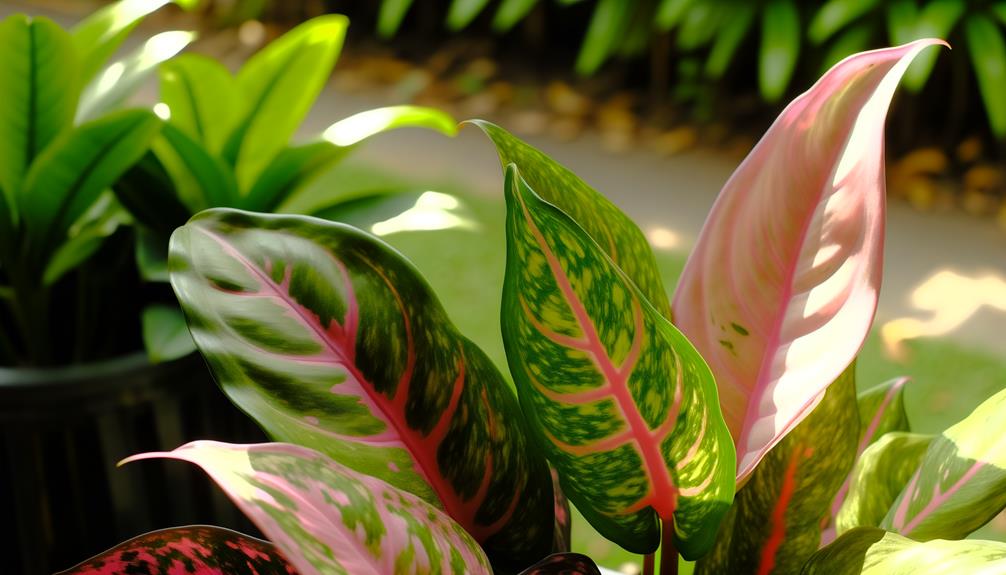
Often observed in controlled horticultural environments, the growth patterns of Philodendron Pink Congo and Philodendron erubescens ‘Pink Princess’ exhibit distinct developmental trajectories influenced by their genetic composition and environmental conditions.
Philodendron Pink Congo demonstrates a more rapid vertical growth, producing elongated stems with limited branching. Its pink coloration is induced chemically, often reverting to green over time, affecting long-term growth uniformity.
In contrast, Philodendron erubescens ‘Pink Princess’ displays a more compact and bushy growth habit, characterized by variegated leaves with stable pink hues interspersed with dark green. This variegation results from genetic stability, fostering consistent growth and maintaining aesthetic appeal.
Both species require specific care to optimize their unique growth patterns, ensuring robust development and visual allure.
Light Requirements
Philodendron Pink Congo and Philodendron Pink Princess exhibit distinct light requirements essential for their best growth.
While both species prefer bright, indirect light, their tolerance to direct sunlight and adaptability to artificial light sources show notable differences.
A comparative analysis reveals the specific light conditions each plant thrives under, aiding in their effective cultivation.
Optimal Light Conditions
Ensuring appropriate light conditions is crucial for the health of both Philodendron ‘Pink Congo’ and Philodendron ‘Pink Princess‘, as these species thrive under specific lighting environments.
Philodendron ‘Pink Congo’ (Philodendron erubescens ‘Pink Congo’) prefers bright, indirect light to maintain its vibrant coloration. Insufficient light may cause the plant to revert to green foliage.
Similarly, Philodendron ‘Pink Princess’ (Philodendron erubescens ‘Pink Princess’) also requires bright, indirect light to sustain its characteristic pink variegation. Inadequate lighting can lead to a loss of the pink hues, resulting in mainly green leaves.
Both species benefit from consistent light exposure, ideally around 10,000 to 20,000 lux, to promote best growth and coloration. Proper light management is critical for maintaining their aesthetic appeal and overall importance.
Direct Sunlight Tolerance
Direct sunlight exposure can be harmful to both Philodendron erubescens ‘Pink Congo’ and Philodendron erubescens ‘Pink Princess’, as their delicate foliage is susceptible to sunburn and discoloration under intense, direct rays.
These plants thrive in environments where they receive filtered, indirect sunlight, which replicates the dappled light they would naturally experience under the canopy of rainforests.
Prolonged exposure to direct sunlight can result in leaf scorching, characterized by brown, crispy edges, and a general decline in plant health.
For best growth, situating these philodendrons in a location that receives bright, indirect light for most of the day is recommended. This ensures they maintain their vibrant pink coloring without the risk of photodamage.
Artificial Light Adaptability
In indoor settings, both Philodendron erubescens ‘Pink Congo’ and Philodendron erubescens ‘Pink Princess’ can adapt well to artificial light, provided it mimics the intensity and spectrum of natural sunlight. These plants thrive under LED grow lights that offer a full spectrum, including blue and red wavelengths essential for photosynthesis. It is important to maintain a consistent light schedule, ideally 12-14 hours per day, to simulate natural conditions.
| Aspect | Philodendron ‘Pink Congo’ | Philodendron ‘Pink Princess’ |
|---|---|---|
| Light Intensity | Moderate to Bright | Moderate to Bright |
| Spectrum Requirements | Full Spectrum (400-700 nm) | Full Spectrum (400-700 nm) |
| Photoperiod | 12-14 hours | 12-14 hours |
Such conditions ensure optimal growth and maintain the vivid coloration of their foliage.
Watering Needs

When considering the watering needs of Philodendron ‘Pink Congo’ and Philodendron ‘Pink Princess’, it is essential to maintain a balance between moisture and aeration to prevent root rot. Both species thrive under conditions that mimic their native tropical environments.
Here are key points to remember:
- Water Frequency: Water when the top 1-2 inches of soil are dry. Overwatering leads to root rot.
- Water Quality: Use distilled or rainwater to avoid mineral buildup, which can harm the roots.
- Humidity: Maintain ambient humidity levels of 60-70% to support healthy foliage.
- Drainage: Make sure pots have adequate drainage holes to prevent standing water, which can suffocate roots.
Proper watering is vital to sustain the vibrancy and growth of both Philodendron species.
Soil Preferences
Optimal soil conditions for Philodendron ‘Pink Congo’ and Philodendron ‘Pink Princess’ necessitate a well-draining, nutrient-rich substrate to support their vigorous growth and prevent root rot. A mixture comprising equal parts of peat moss, perlite, and orchid bark is recommended, as it provides excellent aeration and moisture retention.
The addition of activated charcoal can further improve the soil by absorbing impurities and preserving freshness. Both species benefit from slightly acidic to neutral pH levels, ideally between 5.5 and 7.0.
Regularly amending the soil with organic matter, such as compost or worm castings, guarantees a consistent supply of essential nutrients. Proper soil composition is essential to maintaining the health and vibrant coloration of these varieties.
Temperature and Humidity
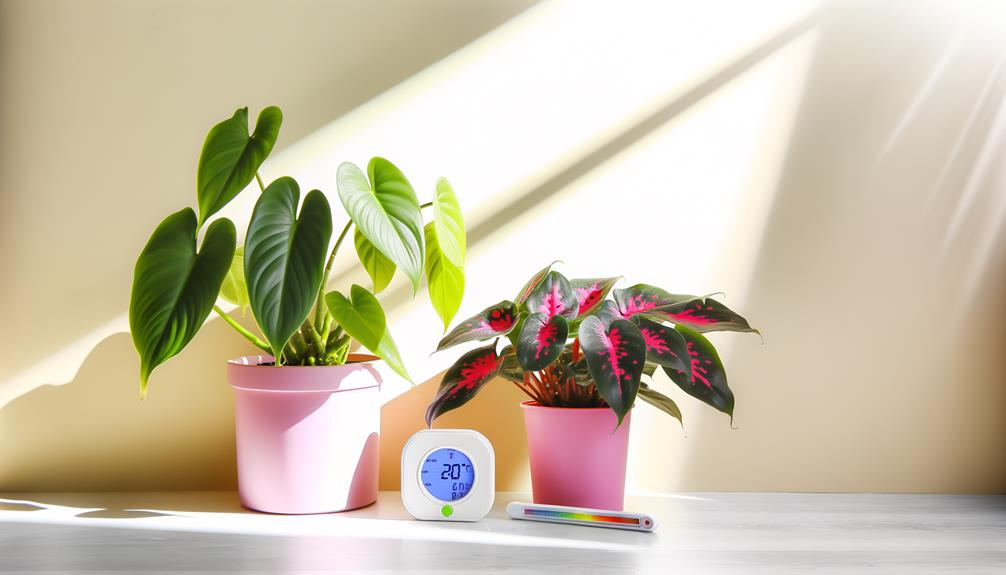
Maintaining ideal temperature and humidity levels is essential for the strong growth and vibrant pigmentation of Philodendron ‘Pink Congo’ and Philodendron ‘Pink Princess’. Both species thrive under specific environmental conditions that mirror their native tropical habitats.
- Temperature Range: Both Philodendron erubescens cultivars perform best in temperatures between 18°C to 27°C (64°F to 81°F).
- Humidity Levels: Best humidity for these plants is around 60-80%. Lower humidity can lead to leaf browning.
- Consistency: Sudden fluctuations in temperature and humidity can stress the plants, affecting leaf coloration and growth.
- Artificial Support: Using humidifiers or pebble trays can help maintain the required humidity levels, especially in drier climates.
Ensuring these conditions are met promotes vigorous growth and maintains the distinctive pink hues of the foliage.
Common Pests
Philodendron ‘Pink Congo’ and Philodendron ‘Pink Princess’ are vulnerable to common pests such as aphids (Aphidoidea), spider mites (Tetranychidae), and mealybugs (Pseudococcidae), which can significantly impact their health and aesthetic appeal. These pests feed on the plant’s sap, leading to leaf discoloration, stunted growth, and potential plant death if untreated.
| Pest Type | Symptoms | Treatment |
|---|---|---|
| Aphids | Yellowing leaves, sticky residue | Insecticidal soap, neem oil |
| Spider Mites | Fine webbing, speckled leaves | Miticides, increased humidity |
| Mealybugs | Cotton-like masses, leaf drop | Isopropyl alcohol, systemic insecticides |
Early detection and regular inspection are vital for maintaining the health of these philodendrons. Employing natural predators like ladybugs can also serve as an effective biological control measure.
Propagation Methods
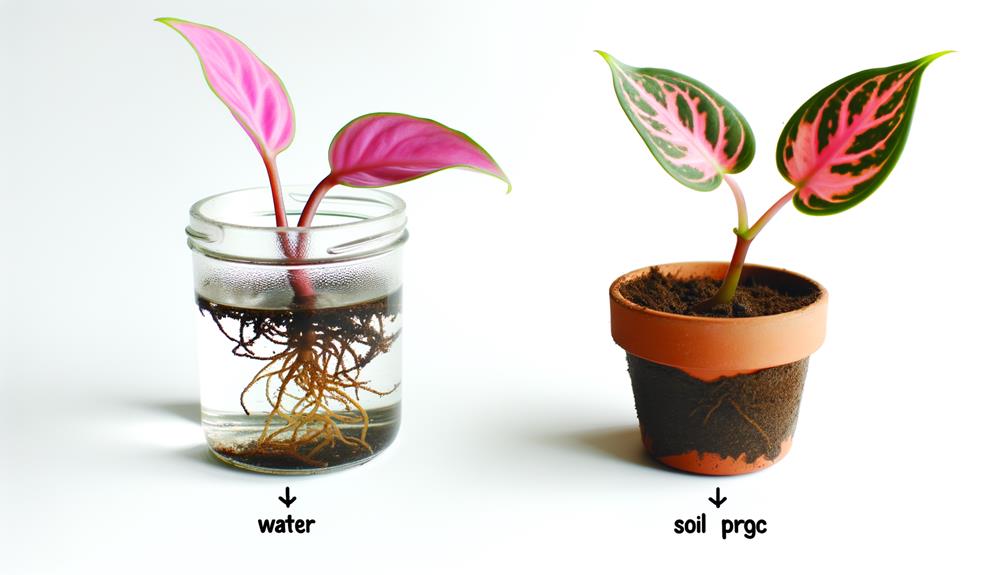
Propagation of Philodendron ‘Pink Congo’ and Philodendron ‘Pink Princess’ mainly involves stem cuttings. This method requires precise cutting techniques and ideal conditions for root development. The application of rooting hormones can greatly enhance the success rate of propagation by promoting faster root growth.
Additionally, consideration must be given to the medium of propagation. Both water and soil offer distinct advantages and challenges.
Stem Cutting Basics
Frequently used in horticultural practices, stem cutting is a reliable method for propagating Philodendron erubescens, including the Pink Congo and Pink Princess varieties. This technique involves severing a portion of the stem to encourage the formation of new roots and shoots.
To achieve best possible results, it is critical to follow these steps:
- Select a Healthy Stem: Choose a stem with at least one node, as this is where roots will form.
- Sterilize Cutting Tools: Use sterilized scissors or a knife to prevent disease transmission.
- Cut Below a Node: Make a clean cut just below a node to ensure sufficient rooting.
- Prepare the Cutting: Remove lower leaves to reduce water loss and promote root development.
These steps provide a foundation for successful propagation.
Rooting Hormone Use
Utilizing rooting hormones can greatly enhance the success rate of stem cuttings in Philodendron erubescens, including the Pink Congo and Pink Princess varieties.
Rooting hormones, typically containing auxins such as indole-3-butyric acid (IBA) or naphthaleneacetic acid (NAA), stimulate root initiation and development.
When applied to cuttings, these compounds mimic natural plant hormones, expediting the formation of robust root systems.
For best results, dip the cut end of the stem cutting into a powdered or liquid rooting hormone before planting. This not only speeds up root formation but also increases the overall viability of the cutting.
Water Vs. Soil
When propagating Philodendron erubescens varieties such as Pink Congo and Pink Princess, the choice between water and soil as a medium greatly impacts root development and plant health. Water propagation allows for easier monitoring of root growth but can lead to fragile roots less adapted to soil environments.
Conversely, soil propagation promotes stronger, more resilient root systems but requires careful moisture management. Here are key considerations:
- Water Propagation: Provides clear visibility of root development and reduces initial transplant shock.
- Soil Propagation: Encourages robust root structures capable of better nutrient uptake.
- Humidity Control: Essential in both methods; high humidity aids in root formation.
- Transplanting: Water-propagated roots may need acclimatization to soil conditions, whereas soil-propagated roots shift smoothly.
Conclusion
In the intricate dance of horticultural preferences, the Philodendron ‘Pink Congo’ and Philodendron ‘Pink Princess’ reveal nuanced differences. Their origins, foliage, and growth patterns, coupled with specific light, watering, and soil requirements, present distinct cultivation challenges. Temperature, humidity, and pest resistance further delineate their care.
Yet, one question remains tantalizingly unresolved: which will flourish more vibrantly under meticulous care, the enigmatic ‘Pink Congo’ or the striking ‘Pink Princess’? The answer lies in the hands of the dedicated cultivator.

